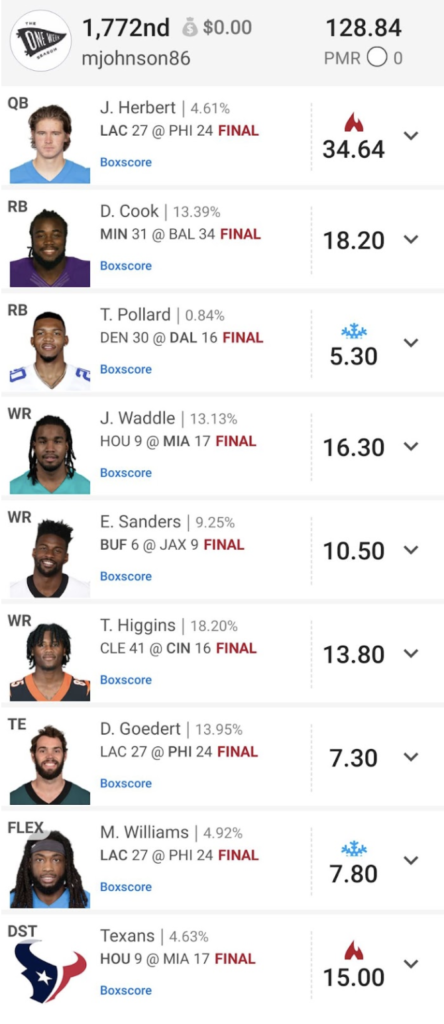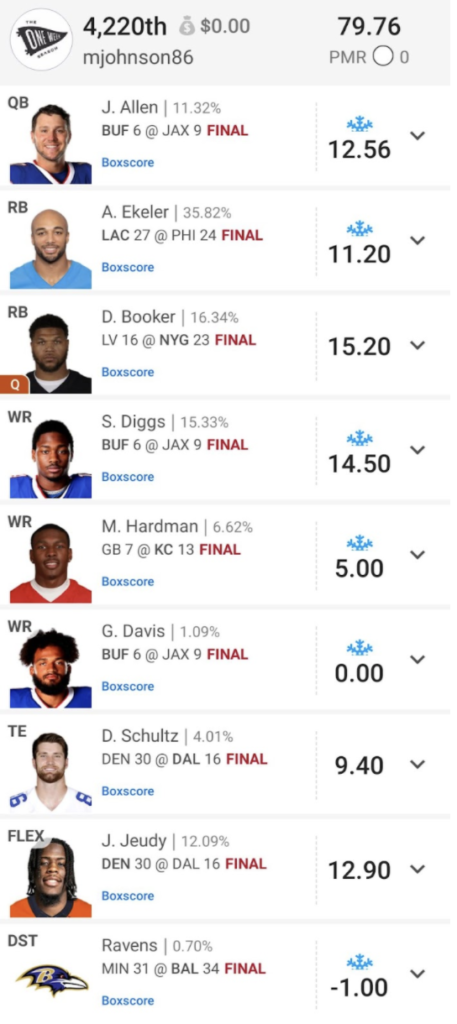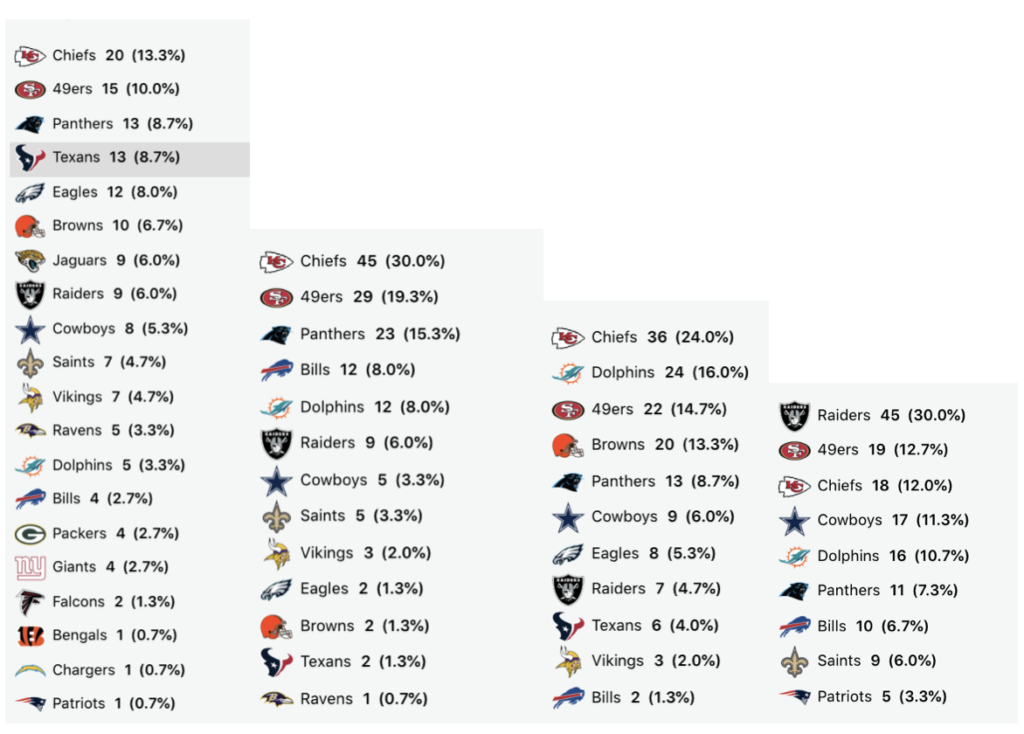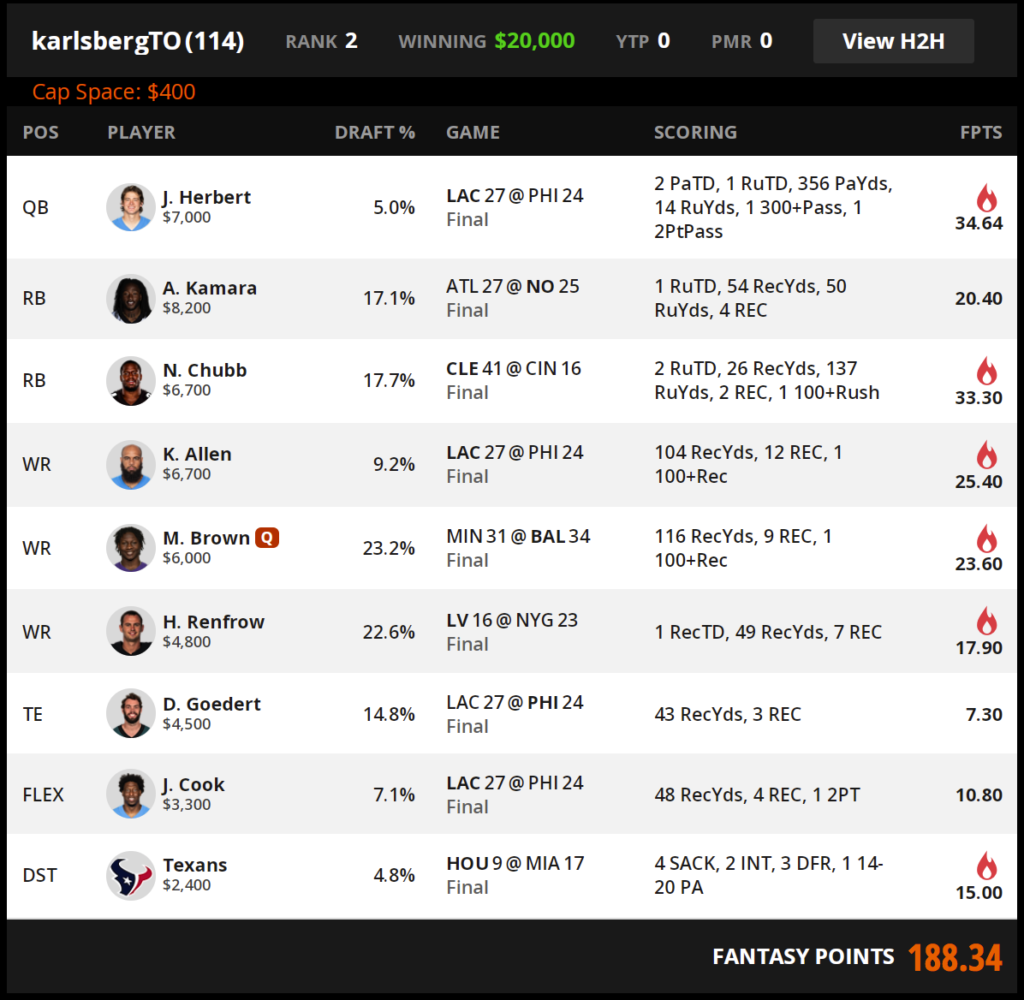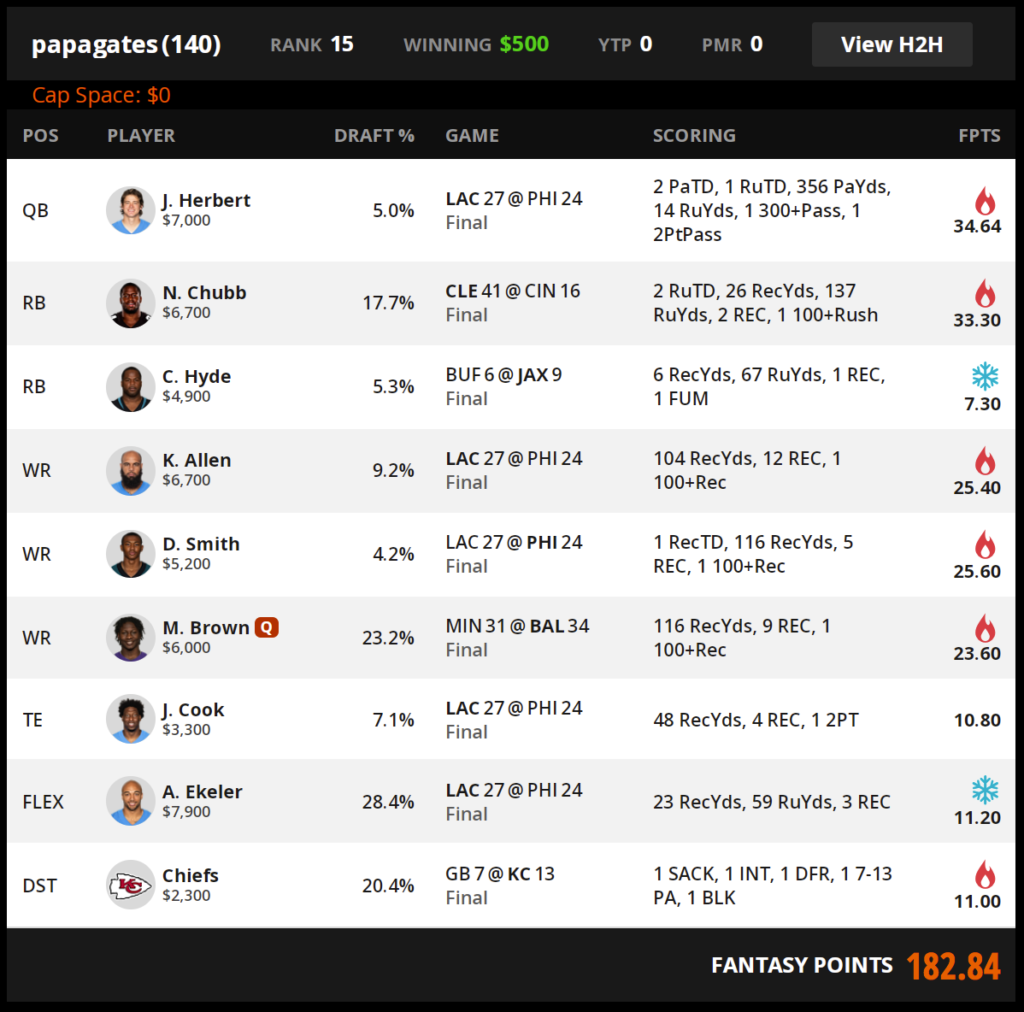Be Mindful of Sharp Objects
Sometimes when building rosters, we can feel somewhat isolated, alone in our DFS bubble, accompanied only by our optimizer and our demented thoughts. Aside from the “picking players” part of the process, there are myriad questions we may ask ourselves in terms of an overall approach. I often wonder if the sharpest players in the DFS world spend as much time on certain aspects of the game as I do? Should I be fading the chalkiest defenses? How tight should my player pool be, and is that strictly dependent on how many quarterbacks I play? Should I be running 4-stacks exclusively? Or are skinny stacks the better way to go? Should I always utilize a bring-back?
To help answer some of these questions, I downloaded the data from nine of the most successful DFS tournament players so we can analyze how they attacked the $5 Flea Flicker on DraftKings. Perhaps comparing the “sharps” handling of Week 9’s decision points to our own will help us either move forward with some validation or identify a leak in our MME game. All of these players entered the maximum 150 lineups for a total of $750 with various results.
Our subjects of the week (along with their respective profits) are:
ahitspat: -$539
BRORANNOSAURUS_FLEX: -$505.75
ChipotleAddict: -$507.69
giantsquid: -$512
GreyPoupon: $665
karlsbergTO: $19,775
meaganjoy: -$590
oxenduck: -$363
papagates: -$53
Out of the gate, it’s nice to see I wasn’t the only one who lost 70% of my tournament buy-ins this week. This is actually a somewhat common occurrence, even in weeks that weren’t as upside down as Week 9. Of these professional players, only two of them ended the day with more money than they started with. Losing your ass is the expected outcome for the majority of weeks in MME. The key is maximizing those weeks when you do hit like karlsbergTO managed to do this week.
Let’s get the DST question out of the way first. Isn’t it optimal game theory to fade the cheap, chalky defenses? If you judge these sharp players on their actions, the answer comes back a resounding NO. The salary savings far outweighs the ownership disadvantage, according to the sharks. Play the chalky cheap defenses and play the low-owned cheap defenses. Use your money to go up a level at another position.
Here’s a sampling of screenshots to illustrate:
I personally end up more like that first screenshot which belongs to BRORANNOSAURUS_FLEX. I usually cap my defenses at 15% and set the Randomizer/Range of Outcomes to “infinity,” and try to spread the DST exposure as much as possible. Defensive scoring is so random in the NFL, and it’s often the interception returns and kick return TDs that we need. Those can come from anywhere at any time, so I generally subscribe to the philosophy of “just spread it around and hope.”
Stack Sizes and Player Pools
Successful players approach stacking in a variety of ways. Most tend to be QB-specific. Others, like AL_Smizzle and mrgoodseats, have a hard and fast rule of using 4-stacks. QB double stacked with exactly one bring-back. If that configuration does not hit on a given week…we’re on to Cincinnati. Grey Poupon, hishboo, and others have had success using mostly 3-stacks with the quarterback, a sole pass catcher, and a bring-back. This approach is a bit more “optimizer-friendly” as it leaves an extra roster spot available for the projections to fill. I like to remain somewhat fluid between these approaches. On certain weeks where I have an abundance of desirable floating plays, I may lean more towards not forcing two pass catchers and a bring-back into my lineups. On other weeks where I have a strong belief in certain game environments, I may simply set the rule to force two pass catchers and a bring-back, move forward, and sleep like a baby.
Wait…where did the term “sleep like a baby” come from, and why the hell does it infer that babies sleep well? Did that asshole ever have kids?
Anyway, here’s the breakdown of our sharps’ stack sizes from their 150 lineups. This shit took forever to log, but it’s important, so I do it for the good of our community. I give, and I give.
ahitspat
Player Pool = 90
Stack Size – number of lineups
Stack of 5 – 6
Stack of 4 – 112
Stack of 3 – 9
Stack of 2 (skinny stacks) – 0
Stack of 0 (naked QB) – 23
Some of the naked QB choices were interesting. Justin Herbert was in two of them. Teddy Bridgewater was in four. These are guys that rarely score an abundance of fantasy points with their legs, and their pass receiver distribution isn’t excessively wide, so I’m not sure of the theory behind this approach. The only obvious answer would be, “I bet these guys throw for multiple touchdowns, and each one goes to a different receiver.” That makes perfect sense. I ran Brady naked a few times in previous years because he was spreading the ball around so much.
*INSERT UNCOMFORTABLE “BRADY NAKED” JOKE HERE
BRORANNASAURUS_FLEX
Player Pool = 106
Stack of 5 – 56
Stack of 4 – 83
Stack of 3 – 11
Stack of 2 (skinny stacks) – 0
Stack of 0 (naked QB) – 0
The number of 5-stacks certainly jumps out here. There is a specific method behind the madness, however. Each of these involves two bring-backs from the opponent, and in every case, one of those opponents is a running back. The approach makes perfect sense. It tells a story of one side smashing with its passing game while the other also put up heavy points, only they are distributed between the air and the ground. If you were to bring it back with multiple wide receivers, then we’d be getting into the argument of “well, you might as well have played the other QB, especially if he was cheaper.”
ChipotleAddict
Player Pool = 77
Stack of 6 – 1 (let Devontae Booker sneak into a Daniel Jones double)
Stack of 5 – 10 (all cases where a RB they liked snuck into a game stack)
Stack of 4 – 54
Stack of 3 – 60
Stack of 2 (skinny stacks) – 25
Stack of 0 (naked QB) – 0
Chipotle played 60% Dalvin Cook this week and planted his flag in two tight ends, 41% Albert Okwuegbunam and 40% Darren Waller.
Giantsquid
Player Pool = 85
Stack of 6 – 10 (He really liked the Giants/Raiders game!)
Stack of 5 – 41 (almost all cases where a RB he liked snuck into a game stack)
Stack of 4 – 61
Stack of 3 – 38
Stack of 2 (skinny stacks) – 0
Stack of 0 (naked QB) – 0
His 3-stacks were all QB double stacks with no opponent. Many of my lineups looked similar this week because there wasn’t a sexy bring-back from the Jaguars in Josh Allen’s stacks, and it was tough to find the salary to bring back Davante Adams or Aaron Jones in Patrick Mahomes stacks, particularly if you wanted both Tyreek Hill and Travis Kelce in there.
He seemed to allow the projections to do their thing. He had 67% Hunter Renfrow and 43% Albert O.
GreyPoupon
Player Pool = 67
Stack of 4 – 2
Stack of 3 – 33
Stack of 2 (skinny stacks) – 115
Stack of 0 (naked QB) – 0
Not a big proponent of “bringing it back,” he only had 26 lineups that featured a quarterback’s opponent.
GP managed to find some success in this tournament by virtue of his running back allocations. Nick Chubb at 45% and Joe Mixon at 26% got him substantially above the field.
karlsbergTO
Player Pool = 84
Stack of 5 – 3
Stack of 4 – 101
Stack of 3 – 44
Stack of 2 (skinny stacks) – 2
Stack of 0 (naked QB) – 0
A firm believer in the double-stack/bring-back philosophy. He only ran threes to provide some diversity in his massive shares of Jalen Hurts (65%) and Justin Herbert (28%)
KarlsbergTO managed to bag 2nd place in this tournament with this lovely 4-stack with tight ends from each side.
Double TE is not an approach we generally advise, but this week it made sense in a few spots, and this was one of them. When both tight ends are part of the game stack, and both have decent TD upside for their price, it’s a green light. Besides, there wasn’t exactly a plethora of viable bring-backs from the Eagles on this occasion.
Meaganjoy
Player Pool = 99
Stack of 5 – 5
Stack of 4 – 65
Stack of 3 – 66
Stack of 2 (skinny stacks) – 14 (mostly Jacoby Brissett with no Texans)
Stack of 0 (naked QB) – 0
Ran 60% Brissett and his next-highest QB was Mac Jones at 10%. Not exactly high-probability decisions here, but hey, meagonjoy won all the money twice in the last year, so what can we say?
Oxenduck
Player Pool = 69
Stack of 7 – 1 (WTF? A Denver/Dallas overdose!)
Stack of 6 – 5 (More Denver/Dallas with some Giants/Raiders)
Stack of 5 – 14
Stack of 4 – 34
Stack of 3 – 68
Stack of 2 (skinny stacks) – 28 (Brissett, Allen, Lamar Jackson and Josh Allen)
Stack of 0 (naked QB) – 0
Quite the portfolio of stacking here. I love it. Every game is different. There is no single approach that always works. Why not try some of everything, especially if the field isn’t?
oxenduck ran 57% Chiefs DST, by the way. One way to handle chalk is to just go way over the field.
Papagates
Player Pool = 78
Stack of 5 – 22
Stack of 4 – 65
Stack of 3 – 59
Stack of 2 (skinny stacks) – 4 (Brissett, Allen, Lamar Jackson, and Josh Allen)
Stack of 0 (naked QB) – 0
papagates was heavy on Daniel Jones (37%), Jordan Love (20%), Dalvin Cook (43%), Devontae Booker (42%), Aaron Jones (33%), Rondale Moore (41%), and Kadarius Toney (34.7%). Do you know what all of these players have in common?
None of them were on the roster of papa’s only sweat.
Another example of the old poker adage. Be aggressive. Even when you miss, you still might have outs and get lucky.
This was a well-constructed 5-stack that featured a Justin Herbert triple stack and the perfect bring-back from the Eagles in Devonta Smith, who made some big plays in the 4th quarter of that game to give this lineup a chance for 1st place.
I hope the exposure to this data helps provide you with some validation on how you currently build your tournament lineups or at least inspires an expansion of your approach.
There’s no one magic formula to tournament success. Be yourself and make sound decisions within your style.
Now let’s freaking bink something in Week 10, huh?
LFG!
